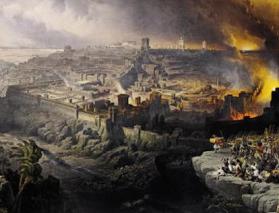In his commentary on Paul’s Letter to the Romans (60-1), Peter Stuhlmacher argues that Paul’s use of hilasterion in Romans 3:25 refers not to a “propitiation” but to a “place” of atonement. The import is that Jesus’ death radically alters the terrain of atonement.
Stuhlmacher writes that through Christ’s redemption “God has . . . completed and brought to an end the sacrificial cult of atonement in the Jerusalem temple in that he has publicly appointed Jesus (on Golgotha) to be the place of atonement for all who believe. The Christian’s kapporet no longer exists hidden in the holy of holies of the temple, but is revealed to all in the form of Christ hanging on the cross. In this Christ, God draws near to his people and speaks to them as he did previously from the kapporet (cf. Exodus 25:22). For the Christian, therefore, there is no longer any need for a priestly mediation between the God who is encountered in secret and the people of God who exist outside in front of the temple. They now encounter God directly in his Christ as the God ‘who was in Christ and who atoned for (reconciled) the world (to himself)’ (2 Cor. 5:19). Through faith in him and through the reception of the atonement from God brought about through Jesus’ blood ‘once for all time’ (cf. Rom. 6:10; Heb. 9:12), the crucified one is active for them as the resurrected one.”
This has much to recommend it: It explains Paul’s language of “public display” – Christ’s death establishes a new way of atonement, and so is as much a public event as the consecration of the temple; it links the death of Jesus to the reformation/revolution that took place in worship; it contrasts the secret, hidden rites of the law with the open encounter with Jesus in the gospel and the church.












